

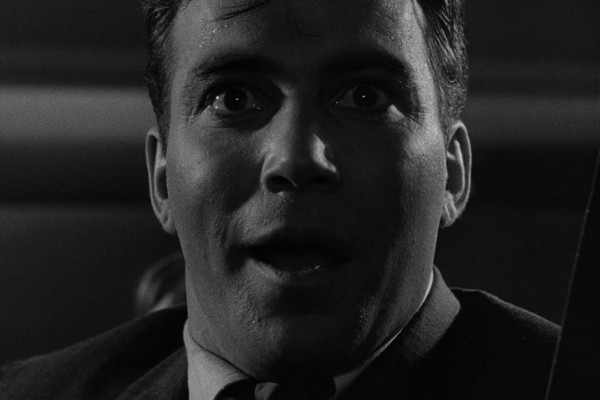
Of all the season five episodes, then Nightmare at 20,000 Feet is the most famous, the most lauded... and the most overrated. Sure, it's not awful. It's actually pretty good, as its relatively high ranking here attests. But an all-time great episode? As a fairly campy "boy who cried Gremlin" tale, it's effective enough, but does seem to shave off multiple facets of the series for cheap jump scares and crowd-pleasing gimmickry. It's ultimately shallow, and not the series capable of its best, despite being nicely produced and well directed by Richard Donner.
At the heart of it - apart from a rather silly-looking "Gremlin" which is more comic than creepy - is William Shatner. An actor who can be charming and charismatic, but has a natural tendency to overplay. Fine in Nick Of Time, but I once saw this episode at a public screening, where Shatner's hammy reactions, as pictured, reduced the entire venue to hysterics. All this said, it looks good, and is probably more effective to the projected 10% of the population who have a fear of flying.
In 1975 Matheson had his own anthology, a watchable, cheesy TV movie called Trilogy Of Terror, featuring three tales all based on his work, the third also written by Mattheson. The DVD release contains a short feature on the author, "Terror Scribe", which features Matheson talking about his work and touches briefly on this episode.
Most famously of all though was the story's remake in the mediocre Twilight Zone movie. Shatner was asked to reprise his role, but had other commitments, so the part was given to John Lithgow, who gives a fine performance in a generally histrionic version. When William Shatner had a guest role in Lithgow-led sitcom 3rd Rock from the Sun, Shatner's character spoke about seeing something on the wing of the plane, only for Lithgow to respond "the same thing happened to me!"
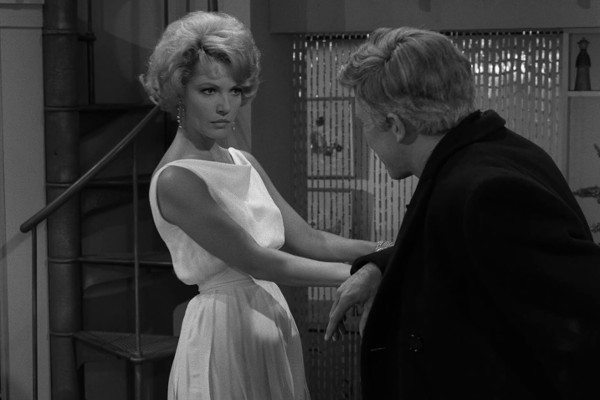
An elderly man (Patrick O'Neal) takes an experimental aging drug in order to be more virile for his much younger wife. Written by Rod Serling from an idea by Lou Holtz, it contains the typical season five darker edges, with brother Raymond (Walter Brooke) threatening flighty wife Flora (Ruta Lee) with the words "I promise you... that if you don't survive, or if you're damaged in any way, I'm going to take it out of her skin. Piece by piece. She's going to donate a pint of blood for every pint that she's bled out of you."
Raymond finally concedes to conducting the experiment on his brother by him threatening to kill himself if he doesn't... as before, suicide and suicide attempts are a surprisingly common motif in the series, occurring as early as the eighth episode. It's overwritten, typical of later Serling scripts, and the "old man" make-up for O'Neal is, while better than many other episodes featuring it, still lacking. But overall this is a decent instalment.
When the series entered syndication, five episodes were removed from the package for many years and for a variety of reasons. Three of the episodes - Miniature, Sounds And Silences and this one - underwent litigation from writers who claimed that their ideas had been stolen. (In the case of Sounds And Silences, this may have been unwittingly the case, as Serling had rejected a script with a similar theme and name two years earlier... it was settled for $3500). An Occurrence At Owl Creek Bridge was only a two-broadcast deal at the outset, and the reasons for The Encounter being taken out of syndication have never been made quite clear, though were probably due to the high racial content. When the legal cases were over, the first three episodes were released back to the public as part of 1984's The Twilight Zone Silver Anniversary Special. Patrick O'Neal was the host, and remarked on how the old man make-up he wore in this episode was remarkably close to his own appearance then.

A Richard Matheson script, based on his own 1956 short story. Featuring a future world of 1974(!) where boxing has been illegal for six years and robot boxing has taken over, it sees Lee Marvin down on his luck with a broken robot. Needing to win prize money, he gets his partner Joe Mantell (Nervous Man in a Four Dollar Room) to make him up as a robot, despite all warnings that he'll be killed.
Amazingly, there's no real twist here - although the boxing actually looks pretty realistic, and the episode as a whole looks nice, it just ends with Marvin battered inside a round, showing Balboaesque fortitude in taking a beating from a machine. It's a fine episode, though its place in a series known for twists is unusual. Earlier seasons may have opted to conceal the subterfuge from the viewers, using a full robot face mask, and having the reveal that it was Marvin all along be the twist.
Narratively, then, it's something of a dud, or a dead-end street, but once you're aware of how it all turns out, you can sit back, relax, and appreciate the direction and performances... if not the inappropriate jazzy score. The year after the episode was broadcast, the toy "Rock 'Em Sock 'Em Robots" was released, which may or may not be a coincidence. What wasn't a coincidence was that the short story was adapted again many years later, with Hugh Jackman starring in the 2011 motion picture Real Steel. Cheesy and formulaic, though vaguely watchable, Real Steel lacks the real edges of this Twilight Zone tale.
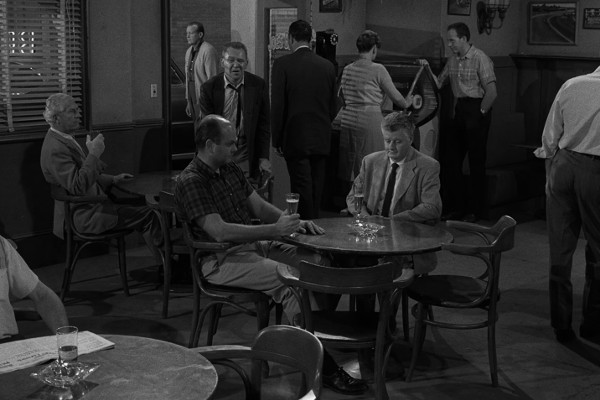
A Kind Of A Stopwatch is the type of episode that has ranked consistently lowly in these articles: a broad Serling comedy with lots of jaunty incidental music, and actors playing to the back row. However, there's such a fun and engaging idea at the heart of this one - a stopwatch that can freeze time - that it gets by almost entirely on its central concept alone.
It's not as if said concept is even explored particularly well. Richard Erdman's chatterbox McNulty lacks the imagination to do much with the device, and the budget seems to lack the ability to let him. Yet on some level, it works, even if you might be distracted by the usually-dapper Mr. Serling having his shirt collar badly tucked in the introduction. The episode was so well-remembered it was parodied in various other cartoons and TV shows, as well as referenced in the Twilight Zone movie ("That's an Outer Limits.") and being virtually remade as one of the best 1980s episodes, A Little Peace And Quiet.
One piece of trivia: this is the last episode to feature the slang term "gleep", following on from its appearances in other Serling episodes Nervous Man in a Four Dollar Room, The Whole Truth and The Bard. Reputedly dating back to the 1940s, the slang term - best translation "old jerk" - clearly never made it into popular use, as its only real occurrences all take place in the series.
Lastly, the post-story "next time" teaser by Rod sees him not ready as the camera rolls, wiping his mouth before delivering his scripted summary. Rod being distracted, or looking off camera for his cue, is a customary trait during the final season. In all it happens during eleven episodes, with perhaps the best example at the end of The Encounter, poor old Rod looking off-screen before delivering his speech.
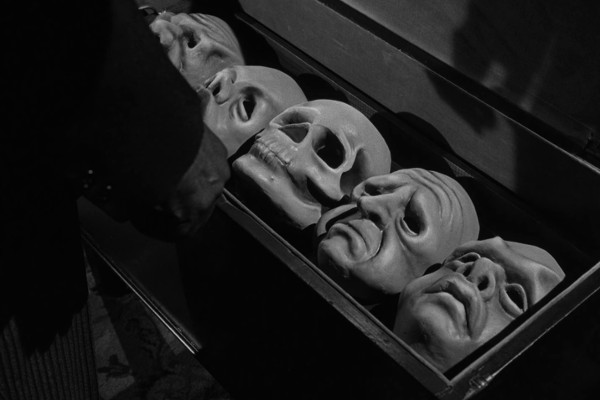
A dying man gets four selfish family members to wear Mardi Gras masks in order to receive their inheritance... yet when the masks are removed, their faces are distorted. There are some unusual choices in this episode, such as the then-characteristic wordiness of Serling's script, or the casting of Alan Sues (then in his late 30s) as a college student. Perhaps most notably of all, however, is the series' sense of imposed justice, which has four people turned ugly... in a series which has previously rallied against judging others on surface values. Not only that, but doesn't the cause of their pain thus condemn himself to the series' own karmic field? After all, they're just shallow and selfish... the elderly man (Robert Keith in his final performance) is a person who has disfigured others, corroding any moral high ground he may have once held. Despite such ruminations, it deserves its top ten placing here, and has the distinction of being the only Twilight Zone episode to be directed by a woman, Ida Lupino.
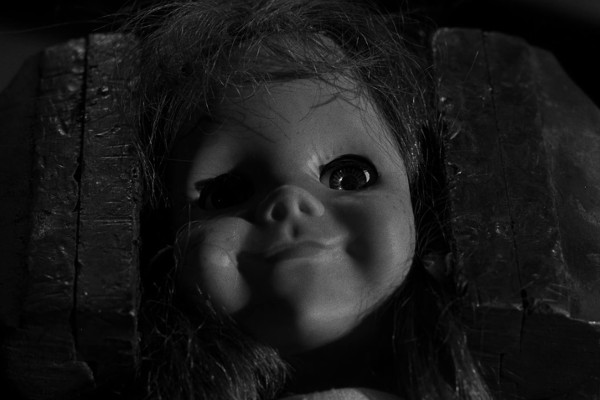
Well shot, well-lit and with a striking score by Bernard Herrmann, Living Doll is one of three "doll comes to life" tales in The Twilight Zone, and by some way the best. Instead of a ventriloquist's dummy like in the other two entries, this is a child's toy that torments bullying step father Erich Streator (Telly Savalas).
Written by Jerry Sohl (credited as Charles Beaumont) what makes this one different but also quite repellent is the character played by Savalas. The Twilight Zone was very much a science fiction series for adults, airing from 10pm (brought forward to 9pm for season four, and then 9:30pm for season five) and yet it's also very much a "family show". Yet here there's a threat of domestic violence throughout, with Streator pushing both his wife and his stepdaughter, and being on the verge of exploding into anger for the whole duration. It makes him a far nastier character than seen before on the programme, particularly as he's so perfectly played by Savalas, and two steps removed from the usual set up.
There is a small question of the ending which, while not bad, is a little perfunctory. As discussed earlier, as the series winds down, many of the tales tend to not have twists, or unexpected directions, but instead go from A to B. So, while not bad, the narrative here sees a now-clichè killer doll threaten to murder Streator... and then carry out her threat. Even more strange is that the doll appeared to despise Streator for his cruelty, but then goes on to threaten the innocent mother.
Lastly, the show returns back to the delightfully twee arrangement of a married couple in separate single beds, which comes as something of a surprise after previous double beds, "orgies" and rolls in the hay. It's also quite startling as it takes place in such a sinister episode.